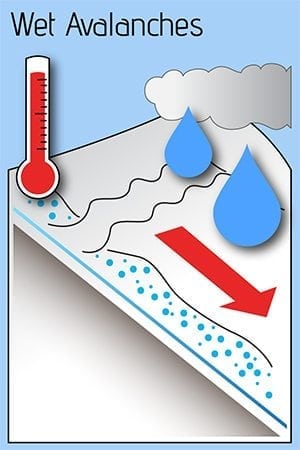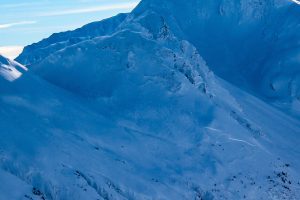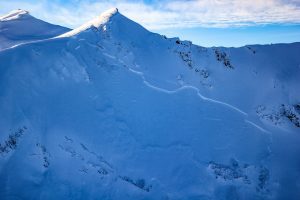Haines Avalanche Center
Above 2,500ftConsiderable
1,500 to 2,500ftModerate
Below 1,500ftModerate
Degrees of Avalanche Danger
Avalanche Problems
Problem 1
The Bottom Line:
Moderate to strong winds out of either side of South have formed tender wind slabs on lee aspects and cross loaded terrain features in exposed areas 1-4’ deep. North can be easier to identify wind loaded characteristics. It is the sneaky corner pockets or specific features on NW/W and NE/E to be mindful of. Avoid steep, complex and possibly challenging terrain that is rocky or thin coverage. Poor visibility will limit travel, but also keep those freshly sculpted cornices on check as well. Always give respect and wide margins. Speaking of… that was a significant storm with critical red flags. However, no notable natural avalanche cycle? Small steps and lots of data is vital for decision making.
The old snow surfaces (bed surface) for winds slabs or settling snow to run on include: rough, smooth, ice, melt-freeze crusts, sun crusts, sastrugi, wind slab and 4-8″ of weak snow. A prior knowledge of where/how these surfaces formed are highly dependent on aspect and elevation.
Any surface avalanches within the new snow could step down to one or more Deep Persistent weak layers and cause a very wide and deadly avalanche. Consequences remain high. Give runout zones a wide berth. Human triggered avalanches are likely and natural avalanches are still possible.
Likelihood:
- Almost Certain
- Very Likely
- Likely
- Possible
- Unlikely
Size:
- Historic
- Very Large
- Large
- Small
Trend
- Increasing
- Steady
- Decreasing
Problem 2
Snow levels reached up to 2500′ over the last 24 hours. Below that level, especially less than 1500′ there was a lot of rain-on-snow. Wet slabs and large wet-loose avalanches are likely today below 2000ft, especially in open terrain steeper than 32 degrees and on South aspects.
Wet avalanches can be very destructive and trigger slab avalanches that break into deeper snow. Wet avalanches include point-releaseavalanches or sluffs. Monitor the snowpack surface, and move to colder, shadier slopes once slush layers form.
Likelihood:
- Almost Certain
- Very Likely
- Likely
- Possible
- Unlikely
Size:
- Historic
- Very Large
- Large
- Small
Trend
- Increasing
- Steady
- Decreasing
Problem 3
Recent heavy snowfall and strong warming is stressing the remaining persistent weak layers deeper down in the snowpack. The result is an increased likelihood of very large and deadly avalanches that can break very wide across a slope.
When seeking out wind protected zones, remember that wind-protected pockets may be harboring buried surface hoar layers. Protected means preserved.
Buried Surface Hoar Layers (These layers have become less reactive in snowpits, but smaller slides could still step down and trigger them):
- Jan 25th melt freeze crust is about 3-4 feet deep (with recent winds and snow, there is a lot of variability on depth of this widespread layer) sitting on top of it are near surface facets, and buried surface hoar from Feb 1-4.
- January 10th surface hoar is now buried about 4-5 feet deep
Old Melt Layers and Crusts:
- Dec 31 surface hoar layer is present in the Transitional and Pass zones, about 5 ft deep. This layer caused some natural avalanches in early January.
- A buried persistent weak layer about 8+ feet deep (The “Big Warmup” Layer, Formed Nov 17th) is still a concern. Numerous natural avalanches observed 1/27 likely on this layer.
- A wide safety margin is necessary. This setup could produce avalanches that break wider than expected, and are most likely to be triggered from shallow trigger points like rocks or small trees. You could ride the same slope numerous times until that right spot produces a large destructive slide.
Pit at Flower Mountain, 2700’, East aspect on Mar 15 (now has an additional 2ft on top). PST 60/100 End on the Jan 10 buried SH 4-6mm that is rounding down 130 cm

Depth Hoar at the Ground (In thinner areas above 3,000′):
- October snow followed by long cold snaps created depth hoar at the ground in most areas.
- You are most likely to human-trigger this layer from shallow spots around rocks, or trees, or have a surface avalanche step down to the ground on this layer. Any slides that break to the ground are likely to be deadly.
Likelihood:
- Almost Certain
- Very Likely
- Likely
- Possible
- Unlikely
Size:
- Historic
- Very Large
- Large
- Small
Trend
- Increasing
- Steady
- Decreasing
Avalanche Activity
March 16: Multiple D2 crowns in cross-loaded gullies 1-meter deep on SW-aspect near 3000ft observed in Lutak Zone.
March 7-9: Multiple D2 natural wind slab avalanches in top 45cm, on wind loaded SW, S, SE aspects in the Transitional zone, 3000-4000ft.
March 4-5: Human triggered wind slab D1/D2 at 5-mile creek Chilkat Pass, 2200ft, W aspect
D2-R4 hard slab: Mid-slope propagation, E aspect, in steep wind loaded area, unsupported slope.
D2-R4 New Faithful, W aspect, high alpine
March 2: Small natural soft slabs were observed in steep trees in the Lutak zone. This kind of small to large natural activity is likely widespread in the Lutak zone.
Feb 19-23: 6 different observations of natural avalanches in the transitional zone and in the Chilkat range. The natural D2 slides were on all aspects, a few on lower angle, all running on a mid-snow pack layer, and a majority with widespread propagation.
A larger, D3-R4 natural avalanche was observed near Four Winds on a S, SW aspect, down 60-120cm, it looked like a loose wet slide that maybe stepped down to a lower layer. Widespread propagation.
Feb 9: Glide cracks ~3000-3400′ in the transitional zone on N, NE aspects. Also notable was observation of reloading of bed surfaces on previous slides.
Jan 28: Two D2’s in the Glory Hole. NW-aspect around 3,200′
Jan 25-29th Multiple wide propagating natural slides released.
Weather
Forecast:
Overcast skies with high of 32 and low of 21F above 1000’. Light East winds with a period of moderate gust in the am. Rain showers expected down low and a few inches of snow at elevation. Freezing levels around 1800’
Recent Weather Summary:
- March 15-16: 2-4 feet of new snow, strong south winds, and warming temperatures, snow levels reached about 2000ft.
- March 4-7 strong NW / N outflow event with cooling temps.
- March 1st brought a strong and cold storm, with 10-15″ of new snow inland, and 30″+ in the Lutak zone.
- Late Feb 20-Feb 23 a cold high pressure system with moderate to strong N, NW winds
- Feb 19-Feb 20- warmer, solar effect on south aspects, valley fog on the 19th at ~1500-2000 ft.
- Feb 12 freezing levels 1250ft
- Incremental snow (more in Lutak zone) since Feb 5th, periods of moderate S/SE winds
- Feb 1-4 Near surface facets on top of crust from Jan 25 warm-up
- Jan 17-26 brought around 5″ of precip (3-5feet of new snow above 3000ft), strong SE winds, and a noticeable warmup
- Surface Hoar and Near Surface Facet growth Jan 8-10
- A strong front brought 24-30″ of snow above 2000ft on Jan 2nd.
- There was widespread Surface Hoar growth on Dec 31st.
- Complete Season Histories: Transitional Zone Lutak Zone
| Snow Depth | Last 24-hr Snow/SWE | Last 3-days Snow/SWE | Today’s Freezing Level | Today’s Winds | Next 24-hr Snow/SWE | |
| Mount Ripinsky @ 2,500′ | 158″ | .6″ / 0.20″ | 42.6″ / 3.70″ | 1900′ | light, variable | .3″ / 0.14″ |
| Flower Mountain @ 2,500′ | 83″ | .8″ / 0.25″ | 27″ / 2.40″ | 1800′ | light, variable | 1″ / 0.30″ |
| Chilkat Pass @ 3,100ft | 54″ | 1″ / 0.30″ | 20″ / 1.85″ | 900′ | light, variable | 1″ / 0.30″ |
Additional Information
WEAR A HELMET! Be careful of rocks and hidden hazards. Be prepared for crevasses when on a glacier.
Are your riding companions trained and practiced in avalanche rescue? Everyone in your group needs to have a beacon, shovel, and probe, and know how to use them. Our mountains have very limited cell coverage, carry an emergency communication device and enough gear to spend the night.
Avalanche Canada’s Daily Process Flow – Utilize this everyday you go out in the mountains.
Announcements
Click the +Full Forecast link below for each zone to read more. If you see any recent natural avalanche activity, or signs of instability please submit an observation.





